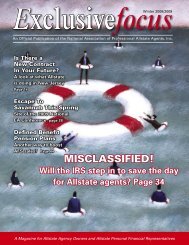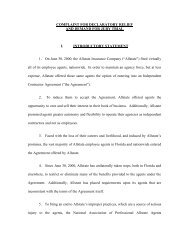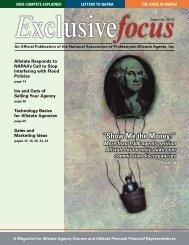EF summer 08.indd - National Association of Professional Allstate ...
EF summer 08.indd - National Association of Professional Allstate ...
EF summer 08.indd - National Association of Professional Allstate ...
You also want an ePaper? Increase the reach of your titles
YUMPU automatically turns print PDFs into web optimized ePapers that Google loves.
ationary period. Once the transition<br />
has been completed to full agent status,<br />
an agent contract is executed and State<br />
Farm and the agent begin their lifelong<br />
partnership.<br />
State Farm agents must maintain<br />
reasonable <strong>of</strong>fice hours, be open on days<br />
when regional customs dictate customers’<br />
expectations, and provide customer service<br />
consistent with a pr<strong>of</strong>essional operation.<br />
That’s it! There are no production quotas,<br />
Expected Results, or any other kind <strong>of</strong><br />
sales volume that must be achieved.<br />
Newer State Farm agents have a tiered<br />
compensation package that <strong>of</strong>fers higher<br />
commission percentages for cross sales,<br />
life insurance production, and higher<br />
auto production numbers. For the new<br />
agents, as is the case for older State Farm<br />
agents, there are no production quotas,<br />
Expected Results, or any other kind <strong>of</strong><br />
sales volume that must be achieved in<br />
order to keep from being fired.<br />
Area Managers are a State Farm<br />
agent’s link to their corporate world.<br />
Area Managers interface with agents<br />
concerning product training, customer<br />
complaints, agent concerns, and corporate<br />
communications concerning market<br />
conditions. Agents may be provided with<br />
peer sales statistics, but they are never<br />
given an “Annual Review” with a contract<br />
terminating outcome.<br />
<strong>Allstate</strong>’s Version<br />
In a market dominated by independent<br />
agents and competitors, such as<br />
State Farm and Nationwide, utilizing<br />
true independent contractor agents,<br />
<strong>Allstate</strong> prefers using an agreement<br />
that, when combined with its 300 page<br />
“Supplement,” more closely resembles an<br />
employee agreement. This agreement is<br />
chock-full <strong>of</strong> employee-like controls and<br />
is administered in the field by layers <strong>of</strong><br />
management. The company’s management<br />
is reminiscent, albeit on a smaller<br />
scale, <strong>of</strong> a “multilevel marketing” or<br />
“pyramid” style structure. This top-down<br />
structure has been entrenched at <strong>Allstate</strong><br />
for decades. The management program<br />
has seen few major changes over the<br />
years, even after the mass conversion<br />
in 2000 when employee agents were<br />
fired and then re-hired as independent<br />
contractors. The most apparent change<br />
to the agency force was that, instead<br />
<strong>of</strong> their managers being called MSMs<br />
(Market Sales Managers), they would<br />
now be called MBCs (Market Business<br />
Consultants). Otherwise, there was little<br />
change and managers, for the most part,<br />
still acted with a sense <strong>of</strong> superiority and<br />
treated agents like employees. With this<br />
management style deeply engrained in<br />
the <strong>Allstate</strong> culture, there can be little<br />
hope that it will change anytime soon.<br />
Why is the company adhering to old<br />
school management techniques which<br />
have their roots in 1950s The reason<br />
for this will be revealed later, but first<br />
we need to look at what makes <strong>Allstate</strong>’s<br />
agent program tick.<br />
The key element to the success <strong>of</strong> this<br />
type <strong>of</strong> management style is control. By<br />
exerting a series <strong>of</strong> pressure points, emanating<br />
from the top, <strong>Allstate</strong> management<br />
can control its agents’ efforts and<br />
shift its focus to accomplish corporate<br />
versus agent driven goals.<br />
The Regional Vice President position<br />
is arguably the most influential position<br />
within the company. Answerable to only<br />
a few above, an RVP controls a litany <strong>of</strong><br />
managers including, in descending order,<br />
the assistant VP, Regional Distribution<br />
Leaders, Territory Distribution Leaders,<br />
Market Distribution Leaders and Inside<br />
Distribution Leaders. This pyramidstyle<br />
hierarchy ensures a “reverse funnel”<br />
effect in which everything flows downhill.<br />
Lower ranking managers report to<br />
their immediate superiors who, in turn,<br />
report to their superiors until the buck<br />
stops at the RVP level. The RVP then<br />
reports to Home Office. At the bottom<br />
<strong>of</strong> this “food chain” are the agents, who<br />
bear the brunt <strong>of</strong> plans and strategies<br />
hatched at the top <strong>of</strong> the funnel.<br />
Back before the year 2000, when the<br />
company acknowledged that it had employee<br />
agents, the management pyramid,<br />
as described above, compensated agency<br />
managers based upon the performance<br />
<strong>of</strong> the agents under their immediate control.<br />
But this performance-based compensation<br />
did not stop at the MSM level.<br />
This performance-based compensation<br />
flowed upstream all the way to the RVP<br />
level, with each level taking a little piece<br />
<strong>of</strong> the agents’ hard work. Some would<br />
equate this to an “upline” in a multi-level<br />
marketing organization. By reversing<br />
the view to that <strong>of</strong> the RVP, it’s easy to<br />
see how that position can enforce a reward/punishment<br />
system for those managers<br />
he controls in his “downline” and<br />
then ultimately to the agent. And while<br />
management titles have changed, the<br />
positions and the basic processes remain<br />
virtually unchanged.<br />
The way it works is that Home Office<br />
establishes a broad set <strong>of</strong> goals and guidelines<br />
for regions to follow. For the most<br />
part, the regions have significant control<br />
over how they achieve their results as<br />
long as they stay within company guidelines.<br />
Obviously, RVPs with higher aspirations<br />
will toe the company line more<br />
so than those who cherish more regional<br />
autonomy. Say, for example, that an RVP<br />
is looking to increase his financial service<br />
Summer 2008 Exclusivefocus — 27

















